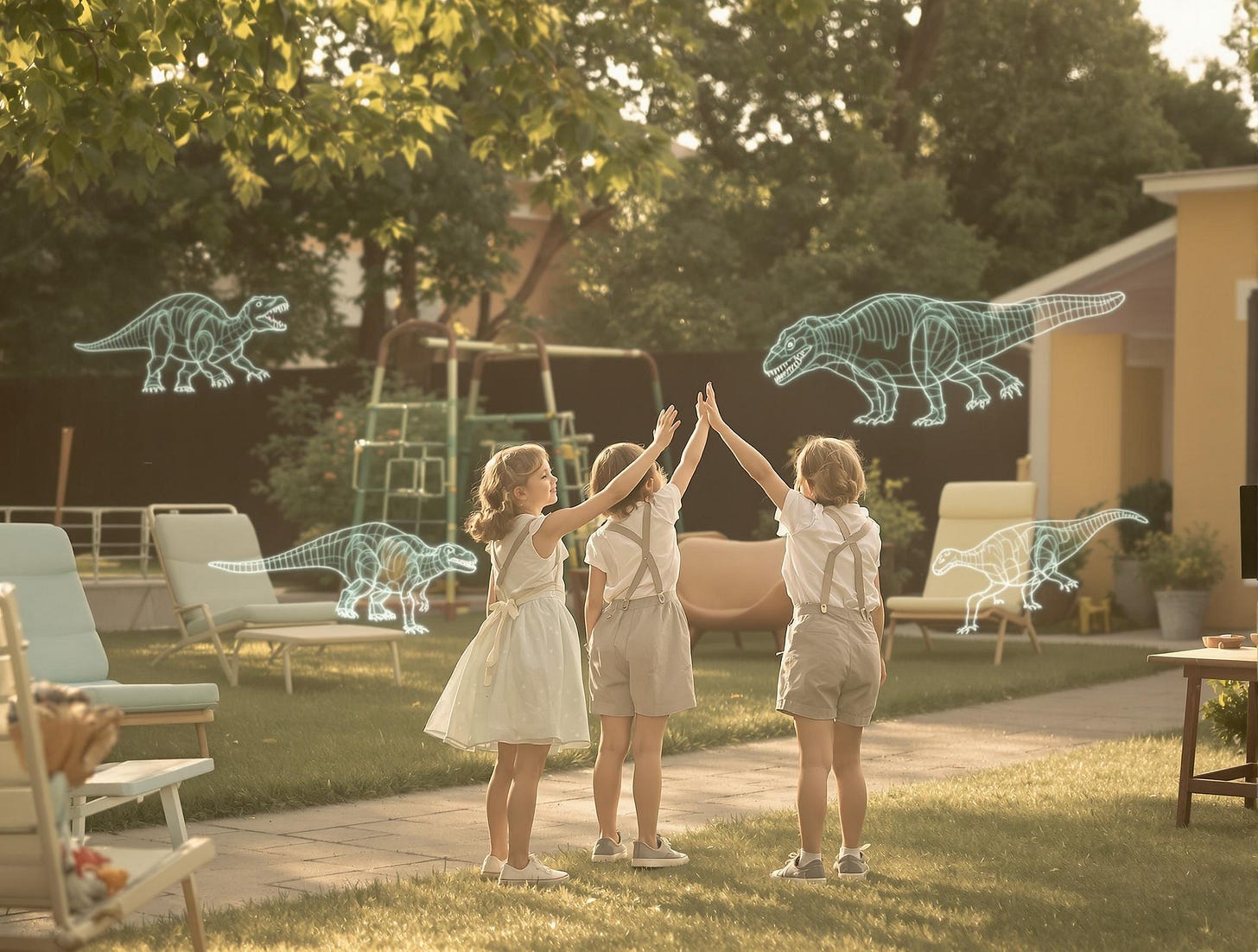For the Alternative Reality Generation, When Did Play Became the World?
As 2028 rolled in, immersive AI reshaped our understanding of childhood connection.
Looking back, it’s hard to pinpoint when play transformed into something entirely new. Perhaps it began when a child used augmented reality to bring a backyard to life with virtual dinosaurs or when kids started recounting stories of their interactions with digital companions as naturally as they once spoke of imaginary friends.
By the late 2020s, alternative reality—the seamless integration of digital elements into physical spaces—had redefined childhood.
Unlike the isolating headsets of early virtual reality, this new technology wove more and more seamlessly into daily life. Augmented reality glasses transformed playrooms into jungles, classrooms into historical adventures, and parks into collaborative gameboards. Digital companions became part of the family—adaptive, ever-present, and deeply personal.
By Christmas 2026, augmented reality and AI technologies had become fixtures on the wishlist, making them integral to how children learned and played. A child might spend an afternoon designing a digital castle in an augmented sandbox, while a holographic storyteller turned bedtime into an interactive experience, responding to every question or fear.
These tools were undeniably helpful. AR glasses translated foreign languages on family trips. Digital companions coached children through difficult homework or guided them during social challenges. For many parents, this seamless assistance felt like a lifeline (akin to taking an iPad to a restaurant had been in 2024)—a patient, ever-available resource tailored to their child’s needs.
Yet, as these tools became ubiquitous, a quieter question emerged: what happens when a child’s most trusted guide isn’t human?
In Henry, an award-winning 2016 Virtual Reality film that depicted a lonely hedgehog yearning for connection, viewers under a certain age felt a surprisingly deep emotional resonance. Around that time, I interviewed the producer, who shared how adults often described the story as touching but fictional, while children spoke about Henry as though he were real.
The moment had come when kids were ready to form emotional bonds with characters that weren’t human.
Psychologists began observing a rise in children who preferred interactions with digital companions over their peers. Why risk the sting of rejection when a digital friend always agreed? Why navigate the complexities of human emotions when digital interactions felt so straightforward?
Parents worried about the long-term effects. Were these bonds fostering empathy and resilience, or were they creating a generation unaccustomed to the imperfections of real-world relationships?
For children, play had traditionally been a way to explore and make sense of the world. But in an augmented reality-driven childhood, play began to take on a performative edge. Games were tracked, scored, and shared in real-time. A scavenger hunt wasn’t just about finding treasures—it was about topping a leaderboard visible to players worldwide.
While some children did well in this gamified environment, others found it overwhelming. Parents reported kids resisting unstructured activities, dismissing them as “pointless” without a measurable reward. The spontaneity and freedom that once defined play were increasingly replaced by systems designed to maximize engagement.
The Limits of Immersion
For all its advancements, alternative reality couldn’t replicate everything. A holographic soccer game might teach teamwork, but it couldn’t capture the exhilaration of a muddy, hard-fought victory. A virtual dive into the Great Barrier Reef lacked the texture of sand between toes or the scent of the sea.
As children grew older, this divide became more apparent. The unaugmented world seemed dull compared to the vivid, responsive digital landscapes they’d grown accustomed to. Teachers reported students struggling to focus on lessons that lacked augmented elements. Families found it increasingly challenging to draw kids into analog activities.
So why was there no significant societal backlash in 2027/28?
We still perceived the balance of pros and cons too enticing; a child might use AR to visualize a science project before building it by hand. A digital companion might encourage a shy student to audition for a school play, blending digital guidance with real-world bravery. These instances suggested a future where physical and digital experiences could coexist meaningfully.
The children raised in alternative reality environments actively shaped their evolution. By their teens, many were designing AR experiences for others, crafting digital worlds that reflected their creativity and individuality. Minecraft on steroids. They became builders, storytellers, and innovators, pushing the boundaries of what these tools could achieve.
But as they transitioned into adulthood, their upbringing left lasting questions.
How would they navigate a world where every interaction could be enhanced or recorded? Could they balance the immediacy of digital tools with the unpredictability of human connection?
The (literal) reality is that we’re still waiting for the answers.
But one thing is clear to me - their legacy will be defined not only by the technologies they embraced but by how they chose to integrate them into the complexities of human life.
[Image credit: AI Brand Photographer at FOMO.ai. FOMO.ai gets brands more traffic.]


